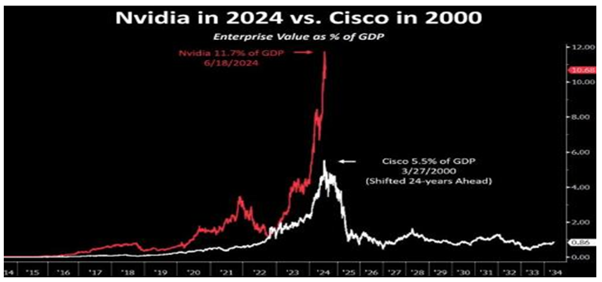Two global technology companies that use AI, but don’t have an “AI” premium
We are in an unusual point in history in financial markets, where money continues to flow into only a handful of companies in the US market and globally, equity flows have concentrated in the largest companies in each country. This has meant that well-managed, quality smaller companies around the world have been neglected.
Artificial intelligence has been around for decades, mainly focused on improving factories and automating processes. The current excitement around its potential to be applied in large language models to improve efficiency in white-collar labour and provide additional services is warranted, but its application will benefit many companies, not just the handful of large companies around the world which are either selling chips or building out cloud infrastructure to run AI models.
Cisco - 2000
The last time a big provider of computing infrastructure was the most valuable U.S. company was in March 2000, when networking-equipment company Cisco took that spot at the height of the dot-com boom.

Cisco was riding the wave of a different revolution—the internet—where its products powered that budding industry. Like Nvidia, Cisco also surpassed Microsoft to become the most valuable company. However, Cisco currently is trading below the share price it reached in 2000, twenty-four years ago. Semiconductor companies are usually cyclical businesses where competitors tend to catch up and develop competing chips and erode the price of the chips as the technology advantage fades. The other thing that is being ignored by the current hype is that although $50 billion has been invested in Nvidia chips over the past year, generative AI start-ups have only brought in $3 billion of sales.
So if not the Magnificent Seven, who?
We have been investing in software providers over the past few decades, that have been adding machine learning into their software and products and continue to focus on these businesses as they generally are not cyclical businesses and therefore don’t see a boom/bust nature in their revenue and earnings streams.
Most services companies are implementing artificial intelligence in their processes and products to either improve internal efficiencies or provide additional functionality in their products. Leading travel advertising portals like Expedia and ecommerce platform JD.com have been neglected by investors over the past five years, despite the companies delivering consistent earnings growth.
Expedia
In 2017, Expedia was trading on a PE of 27x, viewed as a leading technology company with good earnings growth prospects. This has been the case, yet the stock price has not followed their earnings trajectory. Expedia is expected to grow earnings per share by over 20% per annum, yet it is now trading on a PE of 8.5x 2025 earnings.
It launched its artificial intelligence-powered travel planner called Romie in May, yet the stock market has barely blinked. Romie can assist with group chat trip planning when travelers invite it to be their virtual assistant in group chats. The technology can help build travel itineraries, aggregate travel information from emails and suggest activities, dining options and hotels, bookable in Expedia’s travel booking websites. While these technology companies are being ignored by today’s retail investors and institutions, preferring to hug indexes and chase meme stocks like Gamestop, we expect stock prices to eventually rebalance back to reflect underlying fundamentals.
JD.com
JD.com is China’s second largest ecommerce company. It is the leader in direct sales consumer electronics and appliances and has its own logistics unit, which provides a differentiated service of quick and predictable delivery. The company is the leader in online retail of large appliances and has been expanding its categories to include general merchandise and fast-moving consumer goods. They source products from over 50,000 suppliers. JD differentiates with its large range of products at affordable prices, delivered reliably and quickly. They have 1600 warehouses covering all districts in China.
The company continues to invest in smart logistics and is experimenting with unmanned warehouses, drone delivery, self-driving vehicles to improve the efficiency of their logistics. Artificial intelligence is also being used to improve customer satisfaction with features such as “snapshop” that allows users to identify products through uploaded pictures. They are also using AI for customer big data analysis, enabling better predictive offers and product recommendations.
While most technology companies listed in the United States have seen their stock prices appreciate with their rising earnings profiles, Chinese technology companies have seen the exact opposite. JD.com, like most ecommerce companies, benefitted from the covid period in 2020 and 2021. Its stock price peaked at $100 in 2020, when its earnings per share reached $1.63 in that year. Since that time, earnings per share have doubled again to an expected $3.30 this year, yet the stock price has dropped 70% to the current $26.76.
The company generates strong free cashflow of approximately $5 billion per annum. It has a net cash and short-term investments balance of $18 billion, half its current market capitalisation. The company spent $1.3 billion buying back shares this year, representing 3% of shares outstanding. We think the shares are worth double the current stock price and have been accumulating shares over the past quarter.
While companies like Nvidia might be getting everyone’s attention across the globe, it’s worth paying attention to companies that have been using AI tools for years but aren’t getting the headlines. We tend to find these are being discounted by investors and trading on extremely depressed earnings multiples but have clear upside as the money shifts back to pure fundamentals.
4 stocks mentioned

